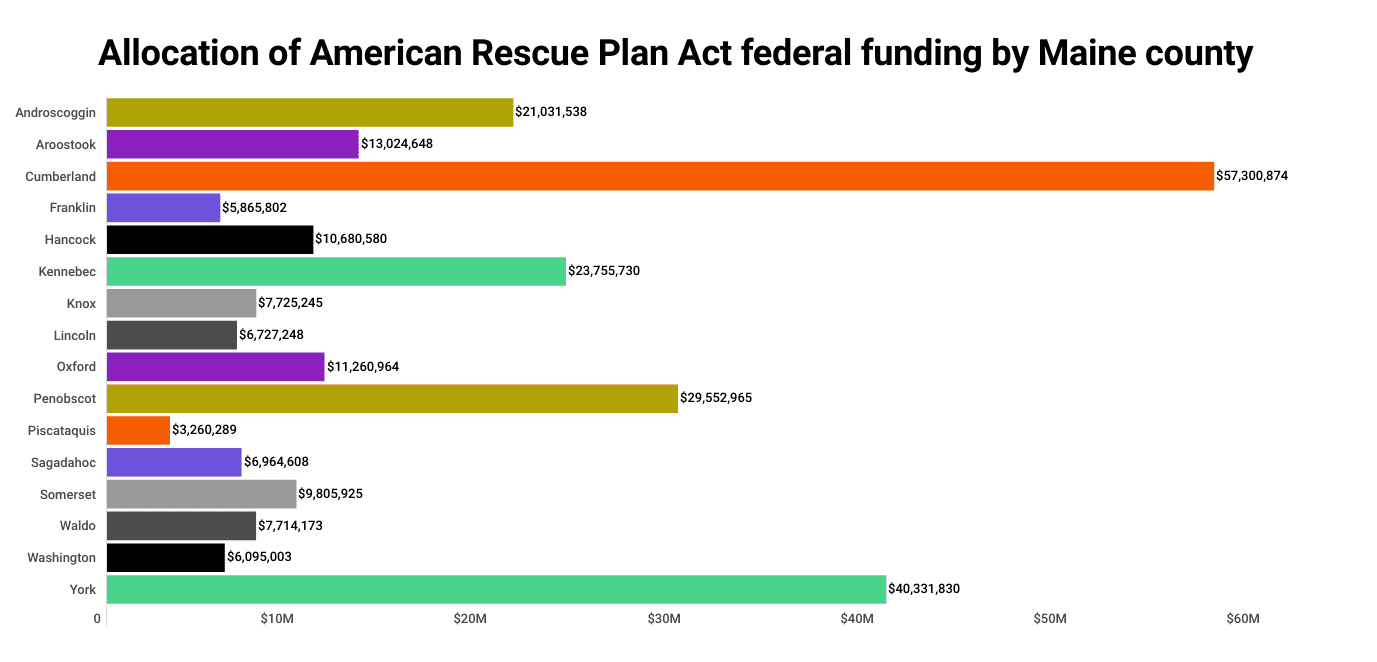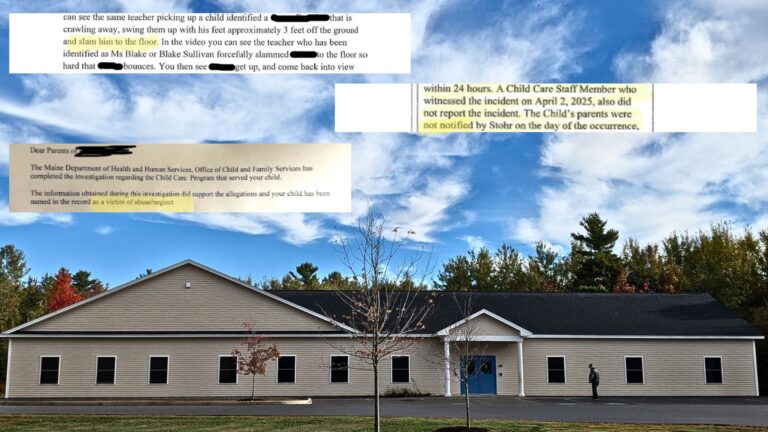With more than $261 million in federal funding flowing in from the American Rescue Plan Act, Maine counties are debating how to use the money, while awaiting further guidance from the feds.
Counties in Maine, which typically are tasked with a relatively few though important duties, are being asked via the federal stimulus dollars to launch an array of projects despite possibly lacking experience in them.
Across the U.S., county governments often do much more. They run expansive K-12 public education systems, for example, and can take the lead on large transit issues.
The quandary in Maine and New England, where county roles are diminished, is how the large amounts of federal money combined with the American Rescue Plan’s tight restrictions on spending, are forcing counties to expand their roles or work with surrounding communities in unprecedented ways.
“I don’t think anybody really thought, ‘How’s it going to impact the counties of Maine and New England?’ because we’re really different from the rest of the country,” said Andrew Hart, the Knox County administrator.
Some Maine counties are receiving more than 100% of their annual, budgeted expenditures from the feds. While the federal cash, also known as the COVID-19 stimulus package, does not need to be spent in one year, comparing the figure to annual budgets helps put the figures into perspective.
York County, for example, is receiving more than $40 million from ARPA, but only spent $21 million in 2021, according to its budget.

With an influx of funds, which cannot be used to cut taxes or reduce annual budgets, counties are trying to create and finance projects that fit into the specific criteria that the U.S. Treasury Department put forward, which are still evolving.

Nick Murray, policy analyst for the Maine Policy Institute, a Portland-based think tank that works to “advance economic freedom and individual liberty in Maine,” said concerns arise naturally given the amount of money coming to small counties. Murray noted that the strict ARPA spending guidelines limit counties’ ability to even spend the money at all.
“It’s an ever, ever shrinking list of things that they can spend the money on,” Murray said. “But the disbursements are probably multitudes more than than most of the reasonable costs would be, I would think.”
PERMITTED USES
Some recommended projects by the federal government include broadband, water and sewer infrastructure, as well as projects that address negative economic impacts from COVID-19, according to the Treasury’s interim final rules. The National Association of Counties wrote a guide for county officials to help them make sense of the rules.
In response to the complicated picture, some Maine counties are choosing to collaborate with municipalities and prioritize needs of the communities within that county. Yet other county governments say they will prioritize county government-oriented projects, ones that an influx of federal dollars could accelerate.
Cumberland County, Maine’s largest, will receive more than $57 million in total ARPA funding. The county’s 2021 expenditures were just under $60 million, according to budget documents.

Because Cumberland County has over 250,000 residents, it must file a “performance plan report” alongside other reporting requirements, according to Travis Kennedy, director of public affairs for the county.
Kennedy called that “a good thing” because “it adds a layer of planning to our process that requires us to focus on equity and fairness.”
“But it certainly is putting us in a position where we’re moving maybe a little bit slower than some of the other counties or towns … because we have this entirely different set of goals that we need to work toward,” Kennedy said.
To help stay in compliance with the extra rules, Cumberland County posted a full-time job, set to last the length of the ARPA funding. The person filling the position will make sure the county makes its audit and reporting deadlines, Kennedy said.
To identify where funds will be spent, Kennedy said Cumberland County officials held a public meeting to talk to municipal leaders, nonprofit groups and others about how to use the funds, as well as talking to experts in fields that meet ARPA criteria for projects. As the process moves on, Kennedy said the county will look at how it can reach more community members.
After projects are identified, they will go to a civilian review board, which the Cumberland County commissioners discussed in a July 20 meeting.

While specifics aren’t yet decided as Aroostook County awaits further guidance, administrator Ryan Pelletier said his county will work to take a community-first approach to using Aroostook’s ARPA allocation of just over $13 million. The county’s 2021 expenditures, comparatively, were about $7.3 million, according to budget documents.
“We’ve already kind of made a decision here in the county to partner with the local municipalities pretty heavily,” Pelletier said. “We have a natural relationship with our towns and cities here that’s lasted for a long time, and we feel that they’re a good way to get some of these funds out.”
Pelletier said Aroostook County would like to collaborate with municipalities to pay for a consultant or staffer to help with the ARPA compliance work. That way, municipalities that receive some county funds are also contributing to the cost of overseeing them.
“What we’ve asked them to do is designate or allocate 2% of what they’re receiving directly back to us at the county to help fund that position,” he said.
FEDERAL DETAILS UNCLEAR
Counties around the country were allocated $65.1 billion, second only to state funding, through APRA. Counties must submit an interim report on Aug. 31, but some Maine officials say the federal guidance needs to improve.

“I think it’s just been a little bit of a struggle to know exactly what’s qualified. I mean the guidelines, in one sense, are kind of vague,” said Hart, the Knox County administrator. Plus, he said, “counties in Maine are totally different than counties in the rest of the United States.”
That means programs that fall clearly under the guidelines — like water, sewer and broadband projects — are not as easy to accomplish at a countywide level here. Knox is receiving roughly $7.7 million from ARPA; the county’s 2021 budget listed $11.4 million worth of expenditures.
Some projects that might work for Knox County (although nothing is official) include fixing the jail’s HVAC system. This project should be partially covered because it can be tied to COVID-19; better ventilation can prevent spread of the disease.
Other counties, Hart said, may try to bend the rules to fit projects they want to complete.
“I’m not saying in particular, anyone, but some places are kind of taking it to, ‘Well, I think we can build almost a new jail’ or something like that,” he said. “The big thing with us is, we want to go slow, there’s no rush, per se, because we have to indicate what we’re going to do with the money by 2024. And we’ve got to spend it by 2026.”
County officials also are considering ways to stay in compliance with the federal reporting requirements.
Cumberland County is seeking to hire a full-time position for the job, while other counties — like Aroostook and Knox — seek to outsource that work.
Lincoln County hopes to get help from the state government, according to Sandy Gilbreath, strategic project manager for the Lincoln County Regional Planning Commission, which is managing the county’s ARPA funds. Lincoln will receive $6.7 million from ARPA, with expenditures in 2021 totaling $12.5 million.
Gilbreath said she and others are doing their best to understand the federal rules, but input from the state would be an invaluable resource.
Donald Durrah, the Oxford County administrator, said his county is still looking at the rules and trying to understand what projects would work best. Oxford is receiving $11.2 million from ARPA, compared to $11.3 million in expenditures in its 2021 budget.
So far, Oxford County is looking to spend the money on county-oriented projects first, and then possibly open things up to greater community involvement. The money, he said, could help build some major infrastructure that would alleviate burdens placed on local taxpayers.
“At that point it becomes better for everyone,” Durrah said. “It lessens the tax burden on the towns, it lessens the tax burden on the citizens.”
But Oxford County doesn’t know exactly what projects are eligible yet.
“We have not decided what projects we’re going to do. There are some projects that we are looking at right now to see if they meet the requirements,” he said. “Because there are some needs that we need to address.”
Similarly, Sagadahoc County is still identifying potential projects and will prioritize county projects, administrator William Post said in an email.
As for counties hiring positions and outsourcing some of the auditing work, Murray said that’s “probably a good idea” for any large disbursement. “But I think this is rare in the fact that it is so big and going directly to these places,” he said.
Transparency has been good, he said, but it’s early in the process and such a large amount of money could be cause for concern.
“You have to worry about something like that, you know,” Murray said. “This is temporary money. It’s very possible that counties would try to use it for permanent positions or factoring in these sorts of things.”
That’s already a concern at the state level, he said. It’s imperative “to focus on the fact that it’s temporary funds, and they have to focus on transparency.”







